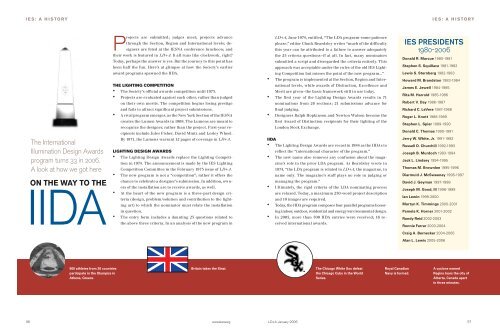COMMeMOratiVe ISSue - Illuminating Engineering Society
COMMeMOratiVe ISSue - Illuminating Engineering Society
COMMeMOratiVe ISSue - Illuminating Engineering Society
Create successful ePaper yourself
Turn your PDF publications into a flip-book with our unique Google optimized e-Paper software.
I E S : A H I S T O RY<br />
I E S : A H I S T O RY<br />
The International<br />
Illumination Design Awards<br />
program turns 33 in 2006.<br />
A look at how we got here<br />
On the Way To THE<br />
IIDA<br />
Projects are submitted; judges meet; projects advance<br />
through the Section, Region and International levels; designers<br />
are feted at the IESNA conference luncheon; and<br />
their work is featured in LD+A. It all runs like clockwork, right<br />
Today, perhaps the answer is yes. But the journey to this point has<br />
been half the fun. Here’s at glimpse at how the <strong>Society</strong>’s earlier<br />
award programs spawned the IIDA.<br />
The Lighting Competition<br />
•<br />
•<br />
The <strong>Society</strong>’s official awards competition until 1973.<br />
Projects are evaluated against each other, rather than judged<br />
on their own merits. The competition begins losing prestige<br />
and fails to attract significant project submissions.<br />
•<br />
A rival program emerges, as the New York Section of the IESNA<br />
creates the Lumen Awards in 1968. The Lumens are meant to<br />
recognize the designer, rather than the project. First-year recipients<br />
include Jules Fisher, David Mintz and Lesley Wheel.<br />
By 1971, the Lumens warrant 12 pages of coverage in LD+A.<br />
Lighting Design Awards<br />
•<br />
The Lighting Design Awards replace the Lighting Competition<br />
in 1974. The announcement is made by the IES Lighting<br />
Competition Committee in the February 1973 issue of LD+A.<br />
• The new program is not a “competition”; rather it offers the<br />
chance to celebrate a designer’s submission. In addition, owners<br />
of the installation are to receive awards, as well.<br />
•<br />
At the heart of the new program is a three-part design criteria<br />
(design, problem/solution and contribution to the lighting<br />
art) to which the nominator must relate the installation<br />
in question.<br />
•<br />
The entry form includes a daunting 25 questions related to<br />
the above three criteria. In an analysis of the new program in<br />
LD+A, June 1974, entitled, “The LDA program-some patience<br />
please,” editor Chuck Beardsley writes “much of the difficulty<br />
this year can be attributed to a failure to answer adequately<br />
the 25 criteria questions—if at all. In fact, many nominators<br />
submitted a script and disregarded the criteria entirely. This<br />
approach was acceptable under the rules of the old IES Lighting<br />
Competition but misses the point of the new program...”<br />
•<br />
The program is implemented at the Section, Region and International<br />
levels, while awards of Distinction, Excellence and<br />
Merit are given—the basic framework still in use today.<br />
•<br />
The first year of the Lighting Design Awards results in 71<br />
nominations from 26 sections; 21 submissions advance for<br />
final judging.<br />
•<br />
Designers Ralph Hopkinson and Newton Watson become the<br />
first Award of Distinction recipients for their lighting of the<br />
London Stock Exchange.<br />
IIDA<br />
•<br />
reflect the “international character of the program.”<br />
•<br />
The Lighting Design Awards are recast in 1984 as the IIDAs to<br />
The new name also removes any confusion about the magazine’s<br />
role in the prior LDA program. As Beardsley wrote in<br />
1974, “the LDA program is related to LD+A, the magazine, in<br />
name only. The magazine’s staff plays no role in judging or<br />
managing the program.”<br />
•<br />
Ultimately, the rigid criteria of the LDA nominating process<br />
are relaxed. Today, a maximum 250-word project description<br />
and 10 images are required.<br />
• Today, the IIDA program composes four parallel programs honoring<br />
indoor, outdoor, residential and energy/environmental design.<br />
• In 2005, more than 500 IIDA entries were received; 16 received<br />
international awards.<br />
IES Presidents<br />
1980-2006<br />
Donald R. Marcue 1980-1981<br />
Stephen S. Squillace 1981-1982<br />
Lewis S. Sternberg 1982-1983<br />
Howard M. Brandston 1983-1984<br />
James E. Jewell 1984-1985<br />
Rita M. Harrold 1985-1986<br />
Robert V. Day 1986-1987<br />
Richard C. LeVere 1987-1988<br />
Roger L. Knott 1988-1989<br />
Stephen L. Spier 1989-1990<br />
Donald C. Thomas 1990-1991<br />
Jerry W. White, Jr. 1991-1992<br />
Russell D. Churchill 1992-1993<br />
Joseph B. Murdoch 1993-1994<br />
Jack L. Lindsey 1994-1995<br />
Thomas M. Brownlee 1995-1996<br />
Diarmuid J. McSweeney 1996-1997<br />
David J. Geyman 1997-1998<br />
Joseph M. Good, III 1998-1999<br />
Ian Lewin 1999-2000<br />
Martyn K. Timmings 2000-2001<br />
Pamela K. Horner 2001-2002<br />
Randy Reid 2002-2003<br />
Ronnie Farrar 2003-2004<br />
Craig A. Bernecker 2004-2005<br />
Alan L. Lewis 2005-2006<br />
900 athletes from 20 countries<br />
participate in the Olympics in<br />
Athens, Greece.<br />
Britain takes the Sinai.<br />
The Chicago White Sox defeat<br />
the Chicago Cubs in the World<br />
Series.<br />
Royal Canadian<br />
Navy is formed.<br />
A cyclone named<br />
Regina tears the city of<br />
Alberta, Canada apart<br />
in three minutes.<br />
56 www.iesna.org<br />
LD+A January 2006 57
















